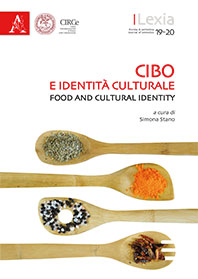Estratto da
LEXIA. RIVISTA DI SEMIOTICA
Cibo e identità culturale | Food and Cultural Identity
The Naïve, the Eccentric and the Maniac: On the Filmic Representation of Vegetarians
LEXIA. RIVISTA DI SEMIOTICA
Cibo e identità culturale | Food and Cultural Identity
The Naïve, the Eccentric and the Maniac: On the Filmic Representation of Vegetarians

ITALIAN TITLE: Il naif, l’eccentrico e il folle: note sulla rappresentazione cinematografica dei vegetariani
ABSTRACT: The goal of this article is to describe and analyse the filmic representation of vegetarian characters in cinema (and, occasionally, TV). As it will be argued in the essay, the topic is not only a study of “food” in cinema (through the representation of a social category that operates a ethical and/or seemingly–healthy selection within their eating habits), but also an investigation on how non–human animals are represented on the screen (vegetarianism being one of many manifestations of the human–animal relationship). By adopting a semiotic methodological interface, the article introduces a number of key–vegetarian filmic characters (27, in total), describing them in the way their eating choice was crucial in the film’s representation strategy. A particular emphasis, in the latter process, is given to Lauren Rosewarne’s model for the cultural interpretation of vegetarians in society.
KEYWORDS: vegetarianism; non–human animals; representation; human–animal relationship.
ABSTRACT: The goal of this article is to describe and analyse the filmic representation of vegetarian characters in cinema (and, occasionally, TV). As it will be argued in the essay, the topic is not only a study of “food” in cinema (through the representation of a social category that operates a ethical and/or seemingly–healthy selection within their eating habits), but also an investigation on how non–human animals are represented on the screen (vegetarianism being one of many manifestations of the human–animal relationship). By adopting a semiotic methodological interface, the article introduces a number of key–vegetarian filmic characters (27, in total), describing them in the way their eating choice was crucial in the film’s representation strategy. A particular emphasis, in the latter process, is given to Lauren Rosewarne’s model for the cultural interpretation of vegetarians in society.
KEYWORDS: vegetarianism; non–human animals; representation; human–animal relationship.
| pagine: | 283-297 |
| DOI: | 10.4399/978885488571418 |
| data pubblicazione: | Giugno 2015 |
| editore: | Aracne |








